Translation management
What Makes a Translation Management System, and How to Choose the Right One for Your Needs

Doing business globally requires brands to speak the language of the buyer. To understand and engage with a product, customers across the globe expect quality content that considers their cultural context at every stage of the buying cycle.
One of the most effective ways to deliver it is by using a translation management system (TMS). Designed to help businesses automate, translate, and manage content for international markets at scale, a TMS is an important resource for global growth.
We’ve put together this guide to help you choose the right TMS for your business. It addresses key features and benefits, requirements, and best practices for integrating a future-proof solution for translation management into your global strategy. Let’s dive in.
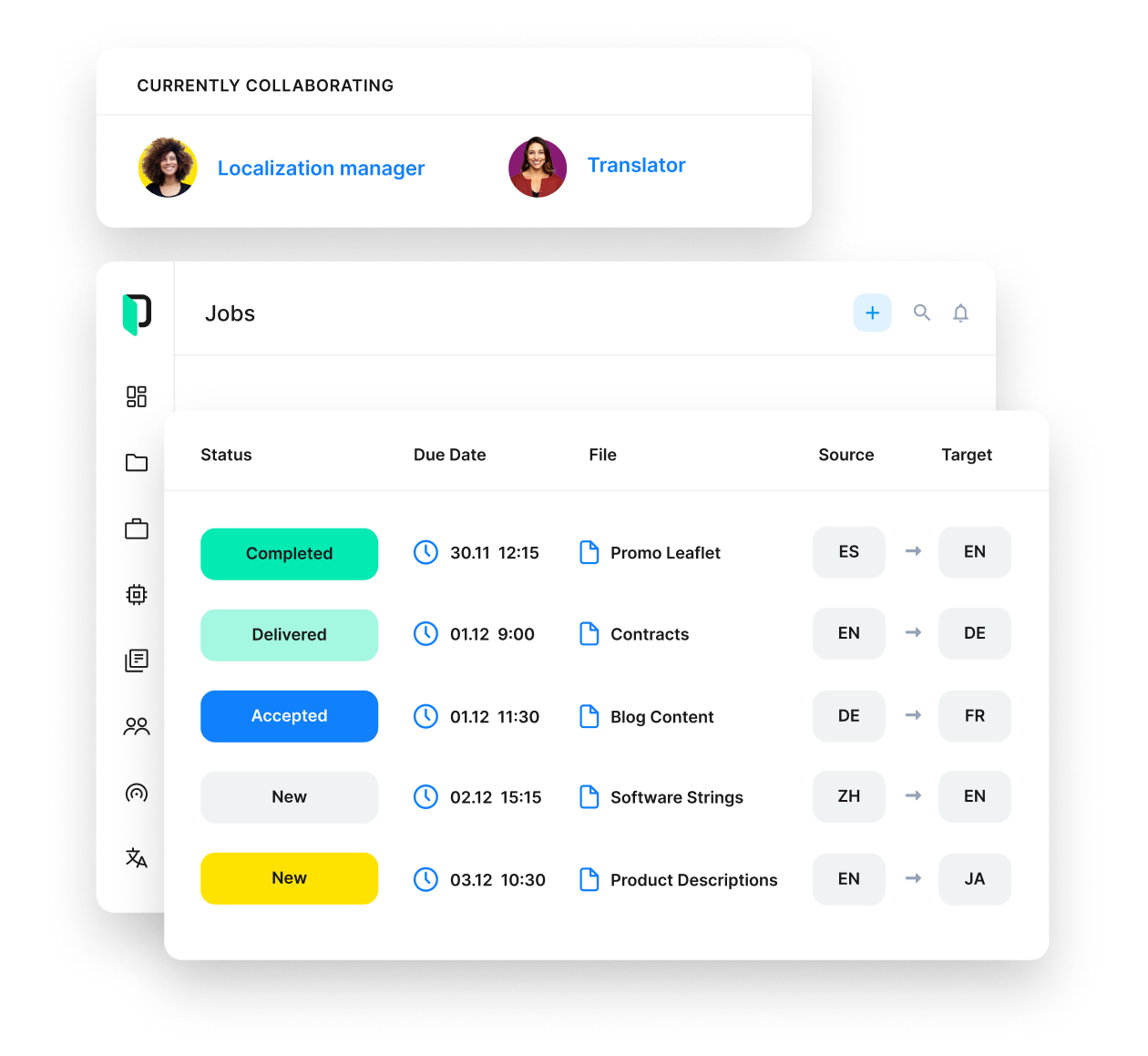
Phrase TMS
The enterprise-ready translation management system
Work with the leading TMS to automate translation workflows with cost control and quality checks.
What is a translation management system?
A translation management system is software that automates repetitive or manual tasks to make the translation process as efficient as possible.
Imagine you want to offer your product in Spain and need to launch both your website and a marketing campaign in Spanish. To achieve that, you’d need to work with translators, designers, developers, marketers, copywriters, local market specialists, etc. Add a dozen more steps for them to follow, and you may realize how large the margin for error and misunderstanding could be.
Similarly, if there are unexpected changes to the source content, your existing translations need to be updated immediately. This makes it necessary to start the entire translation process from scratch: extract source content, have the translation done, review the updated website source files, and ask a developer to update the web pages—all of which costs time and money.
With a translation management system, handling repetitive or manual tasks becomes a thing of the past. From uploading and translating to publishing content in multiple languages, a TMS uses automation to improve efficiency and scalability for growing companies that use content to connect with customers across markets.
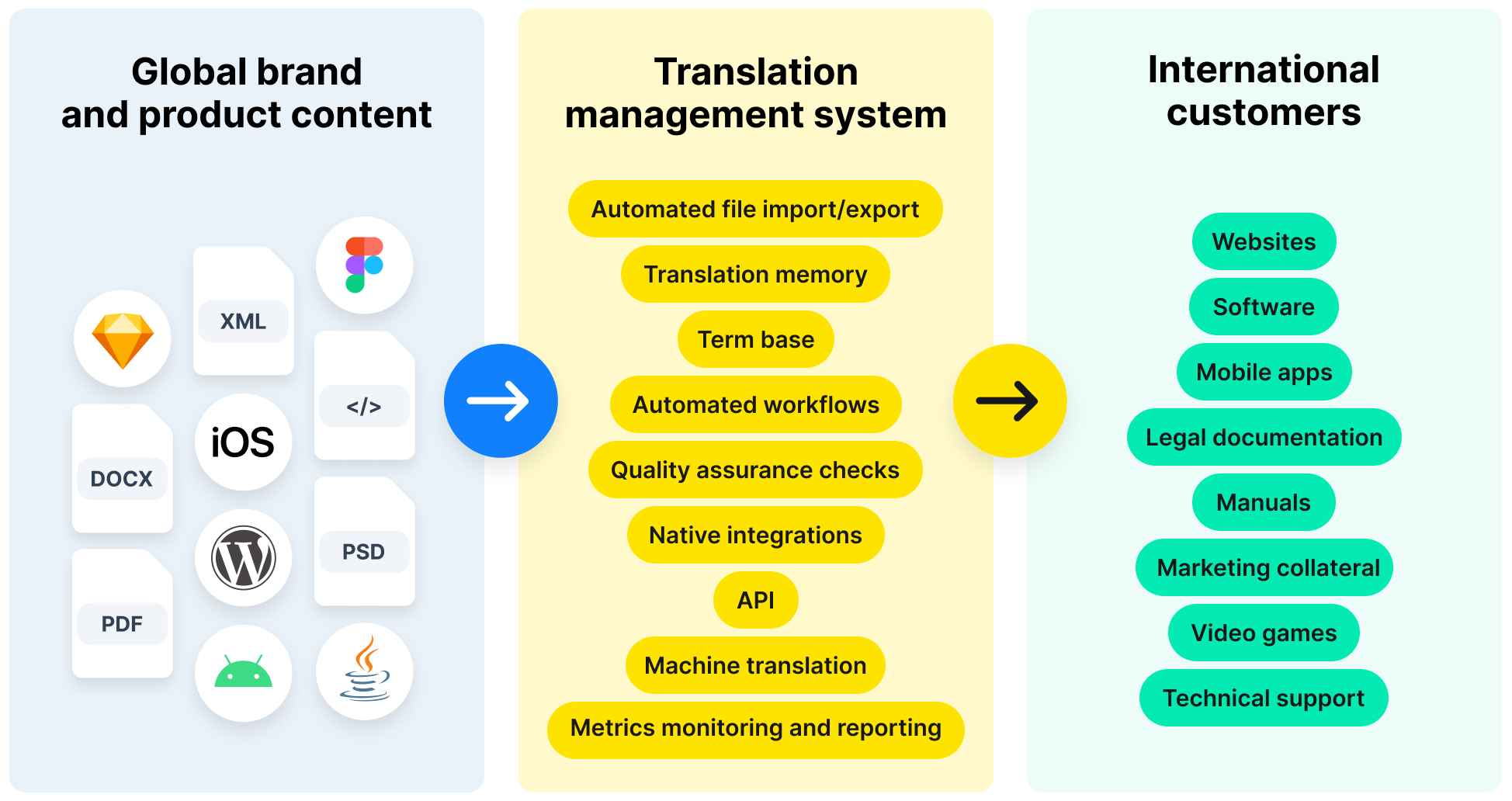
A TMS is at the heart of continuous multilingual content delivery worldwide
The difference between translation and localization
Whether you have a website, web/mobile app, legal/technical documentation, or marketing materials, it’s crucial to remember that translation is only one step in the overall process of localization—which ensures the all-around readiness of a product or service for a target market beyond just the written word.
The moving parts of localization require a high degree of organization and control to successfully launch products across languages and cultures. By combining traditional computer-assisted translation (CAT) tools and machine translation capabilities with project management and business intelligence features, a TMS can serve as the central hub for adapting a product to a specific culture and language.
To better understand what makes a TMS, it helps to differentiate between translation and localization. Both terms often tend to be used interchangeably, but they have different definitions.
Translation and localization differ in the following ways:
-
Translation is the transfer of text from one language (the source) to another (the target). The goal is to accurately reflect the meaning and purpose of the original.
-
Localization is the process of adapting that translation to the culture of the target market so that it looks and feels as native as possible.
For example, there are multiple versions of Spanish based on the country or region—European, Mexican, Argentinian Spanish, and so on. Delivering the same translation to all of them can cause different issues: Certain terms may have different meanings, currency symbols will vary, formats for telephone numbers and postal addresses will be different, and the behavior of consumers won’t be the same.
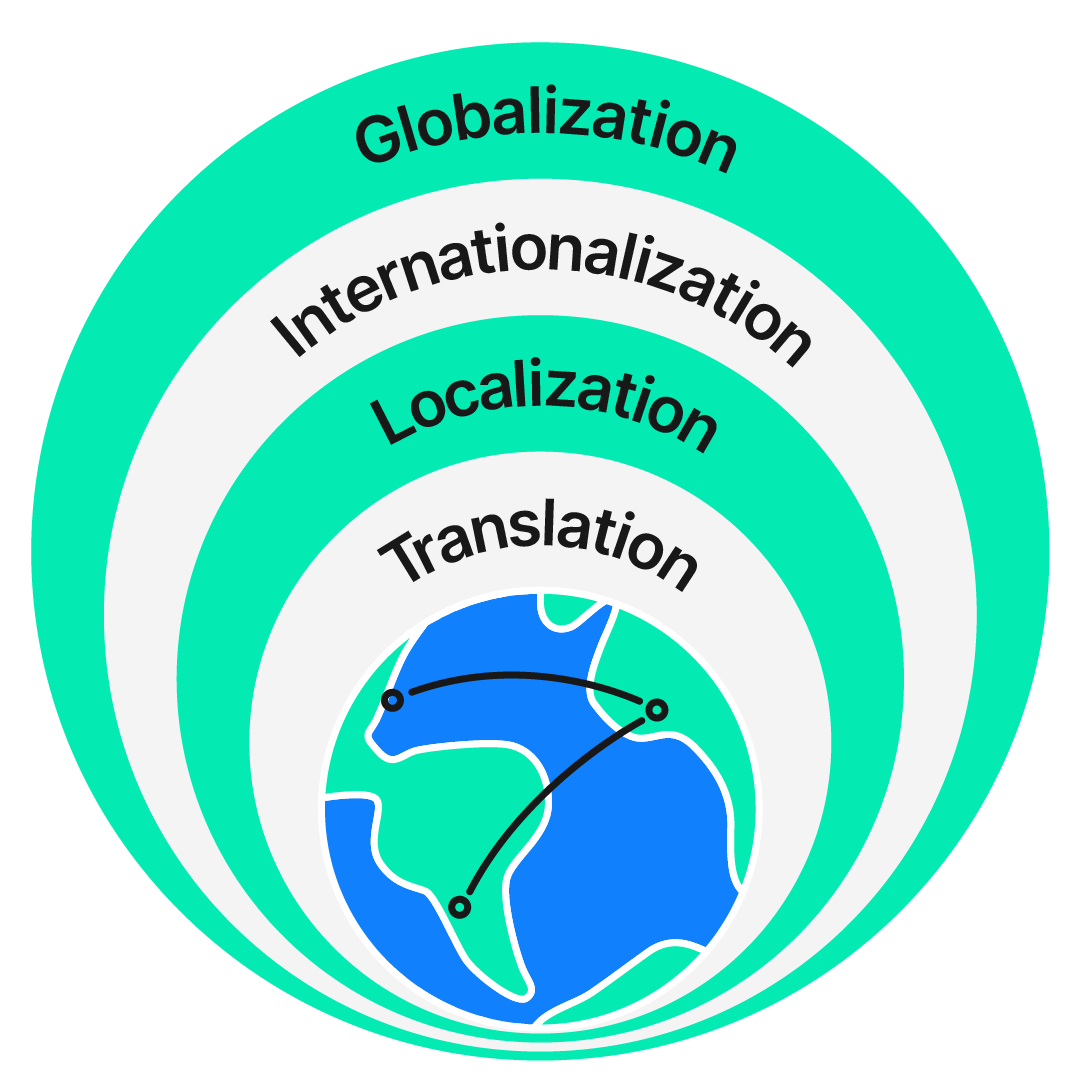
Translation is one of the key components of global business expansion
What are some common features of translation management systems?
Cutting-edge translation management systems utilize cloud technology to offer global businesses online translation software that is easy to implement, access, and integrate. There are many different TMS solutions on the market, but they typically share a core set of functions.
| Team management
Workflow management Time management Translation vendor management Project progress tracking and reporting Billing and invoicing Automated file processing Translation memory (TM), the heart of a TMS, for storing previously translated content that can be reused Translation glossary (term base) for managing approved translations for specific terminology Quality assurance (QA) checks for accurate, error-free translations Screenshots and in-context editors for visual support during translation Out-of-the-box integrations with popular commercial software such as content management systems (CMSs) Application programming interface (API) for integrating a TMS with any preferred software Machine translation (MT) capabilities |
| Common TMS features to look for |
By seamlessly integrating all of the above capabilities, a TMS provides globally distributed teams of any size with a centralized collaboration platform. From product, marketing, and localization managers to translators, developers, and designers—everyone involved can rely on the TMS as the source of truth for all multilingual content used to connect with customers across markets.
Benefits of using a TMS
The process of translating a website or mobile app may not be as structured as translating a book. With customer preferences evolving and content changes occurring daily, managing multilingual content can quickly become a complex and time-consuming endeavor—particularly if handled manually.
Without a translation tool in your digital ecosystem, translators need to coordinate via spreadsheets, emails, or disparate chat tools. Relying on freestanding, special-purpose tools like translation memories and machine translation engines may be helpful, but using them in isolation also adds to the complexity.
As soon as translation requirements get more complex, manual processes can considerably slow things. What’s even more concerning is that when content moves from format to format and person to person, the probability of errors and omissions can increase exponentially.
Translation management systems address all these issues by giving an organization a dedicated workspace for end-to-end translation project management. Let’s look at how a TMS can help growing businesses streamline the process to reach new markets faster.
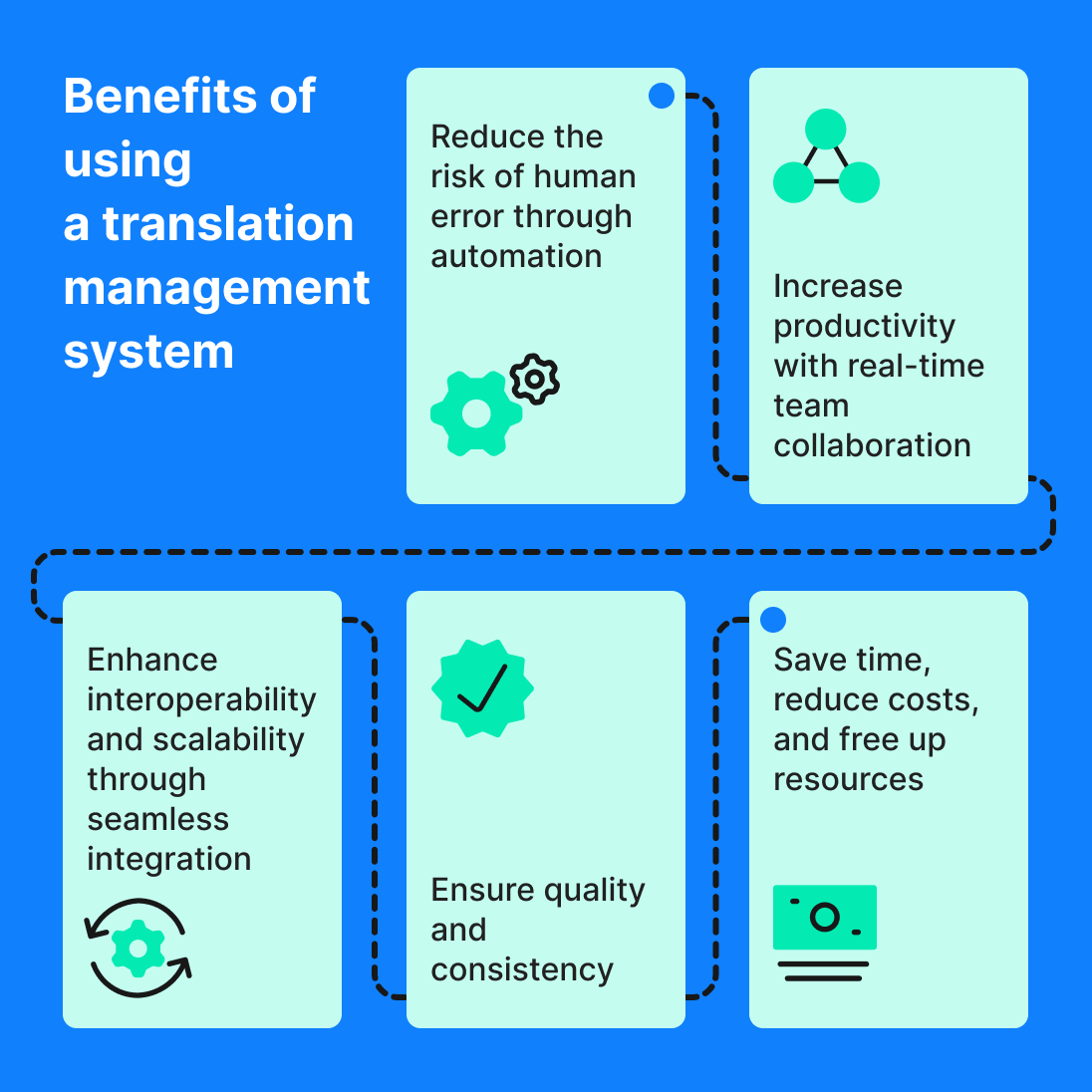
Reduce the risk of error through automation
For decades, spreadsheets used to be the norm for translation. They might have worked for small-scale translation projects, but localization needs have evolved so fast in the ever-growing global marketplace that translation processes can quickly spiral out of control.
In a process where you need to constantly monitor, update, and modify a spreadsheet, it’s easy to make mistakes that lead to copy-and-paste errors, missing data, or incorrect versioning—all of which can translate into a degraded customer experience, loss of potential buyers, and fewer sales.
Translation technology eliminates all those risks and provides a workflow-centric environment for teams to stay on the same page. Since it’s a centralized platform, all users across roles, teams, time zones, or locations can access the same data, update it without hesitation, and see any changes occuring.
With a cloud-based TMS, everyone can be sure they work from a single user interface (UI) with the latest version at all times. Managers know what everyone is doing, what tasks are complete, and where the project stands, and other users can work with greater confidence than they ever did with a spreadsheet.
Increase productivity with real-time team collaboration
Translation is a highly collaborative process involving a dozen of in-house roles as well as contractors scattered around the world. Designed with the whole team in mind, a modern TMS shines with team collaboration functionalities that help you work more effectively as a team.
For example, the ability to leave comments and notes for other team members, send automated notifications to other tools used within the company, and deliver real-time status updates can dramatically boost productivity across the board.
This is equally beneficial when you outsource translation to a language service provider (LSP). A TMS makes it easy to keep full visibility of the work done across projects, no matter if you work with one translation agency or assign multiple vendors to a translation job—eliminating endless email follow-ups.
Enhance interoperability and scalability through seamless integration
A TMS doesn’t operate in a vacuum. Content is usually published on platforms like a CMS or product information management (PIM) software. When translated content is ready, it needs to move into these systems in the correct language. A TMS allows just that by integrating with your existing systems—either out of the box or by letting you use its API to build a custom integration with your preferred tool.
For example, the ability to quickly retrieve materials in the language you need can speed up information sharing in sales. If the TMS is able to integrate natively with your customer relationship management (CRM) system, then it will automatically deliver translated content for the sales team to forward to prospects or customers in a target market.
If the TMS doesn’t offer the native integration you need, it should at least have a robust, well-documented API. Your developers can use the API to create a custom integration with any tool in your tech stack. Still, you should be aware that a custom integration usually comes with costs and maintenance overhead. Therefore, it’s advisable to check if a TMS provider may plan on releasing your desired integration.
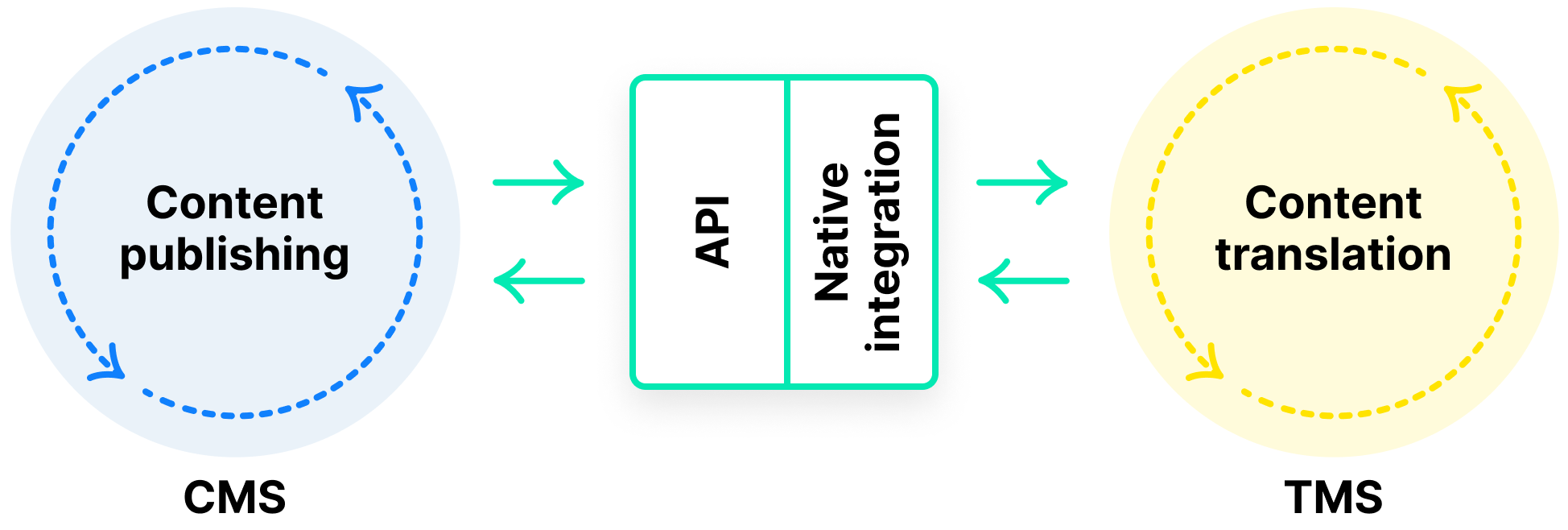
A strong TMS connects with your preferred software either out of the box or through an API
Ensure consistency, accuracy, and quality
Translated content represents your organization in a global transaction. Poor quality or inconsistent style would reflect poorly on your products or services. Maintaining quality is a key reason to invest in a TMS—it helps ensure that each piece of content remains consistent and accurate.
A TMS incorporates 3 core computer-assisted translation tools that help maintain quality and consistency across languages:
- Translation memory: This CAT tool is the heart of a TMS—it saves earlier translations in a database and compares word-for-word matches to determine if the previously translated content can be reused—adding to consistency.
- Term bases: These glossaries give translators and reviewers guidelines on the meaning and usage of key terms that appear frequently in your content—contributing to accuracy.
- Translation style guides: A TMS may support the creation of native language style guides that are automatically included in a translation package—ensuring brand alignment across languages.
Another useful feature for maintaining translation quality is adding comments or attaching screenshots to provide translators with visual context—quite handy when translating software UI elements or working with multimedia content (e.g., videos).
A TMS should also have automatic quality assurance checks to help translators fix typos, formatting issues, incorrect markup, terminology inconsistencies, etc. before completing a translation job.
Save time, reduce costs, and free up resources
Finally, as translation software is all about automation, all capabilities mentioned above serve an important function of reducing time and costs. With many manual tasks eliminated, teams are able to work more efficiently and process large volumes of text in multiple formats and languages more quickly.
Similarly, when all parts of the workflow converge in one system, companies have a better understanding of where costs are coming from and can start taking measures to reduce them. They can identify content that requires fewer edits or can be reused—or find other ways to automate translation management.
For example, more and more companies see machine translation (MT) as a productivity tool to enter new markets more quickly while keeping costs down. By embracing artificial intelligence (AI) and machine learning, they can automatically generate translations that can be post-edited by professional linguists.
Saving time and reducing translation costs with a translation management system frees up valuable resources for growing organizations to invest even more in innovating their product, building their brand, and other strategic initiatives for wider global reach.
On-demand webinar
The benefits of using a translation management system
Learn how a translation management system can help you open the door to global business by automating, managing, and translating all your content into the languages your audiences speak.
The value of a TMS for global organizations
With a translation management system supporting your global strategy from the start, the improved ability to manage multiple languages across a product or service line can lead to 3 key results in the long run:
- Faster time to market
- Greater global brand reputation
- Stronger global revenue growth
A TMS speeds up time to market
Translation can be time-consuming, especially when the volume of product and service information keeps growing. Any tool that makes the translation and localization processes faster than manual management directly impacts the time to market.
Recently, it’s been common for products to sit in warehouses ready for shipping but waiting for translated documentation. As supply chains move faster, a more effective translation process, made possible through an integrated TMS, becomes critical to moving faster when entering new markets.
A TMS strengthens global brand reputation
Reputation is based on the perceived quality, purchase experience, and user experience that customers have when using the product or service. A highly respected international brand can remove cost objections and assure new buyers that the overall experience will be beneficial.
Translated content is often the global buyer’s first exposure to a company’s culture and values. The quality of that translation, how well it respects the buyer’s culture, and the responsiveness of the company when entering new markets are all important. A TMS, with its quality control and review processes, can make a big difference in brand perception and acceptance from day one.
A TMS contributes to global revenue growth
Revenue is directly related to time and reputation. When you’re able to move faster and are perceived as a quality brand, revenue follows.
On the one hand, the faster you can bring a product to new markets, the faster you can start selling it and see localization ROI (return on investment). On the other hand, maintaining a strong brand perception—to which a TMS’s built-in QA processes contribute significantly—results in a positive customer experience across markets that holds buyers and keeps them coming back for more.
Creating effective translation workflows with a TMS
The basic building block of any translation management system is a defined translation workflow. This workflow can vary from project to project and from company to company, but it typically follows a standard pattern:
- Preparing assets and extracting content for translation
- Setting up the localization environment
- Content translation
- Reviewing and approving translated content
- Re-importing translated content back to the source
The TMS automates and streamlines each of these steps while localization managers can keep a helicopter view of the entire process on one platform. It also helps ensure that all parts of the process are completed properly and on time—with no bottlenecks—to keep projects running smoothly. Let’s explore how a TMS can simplify each step in the translation workflow.
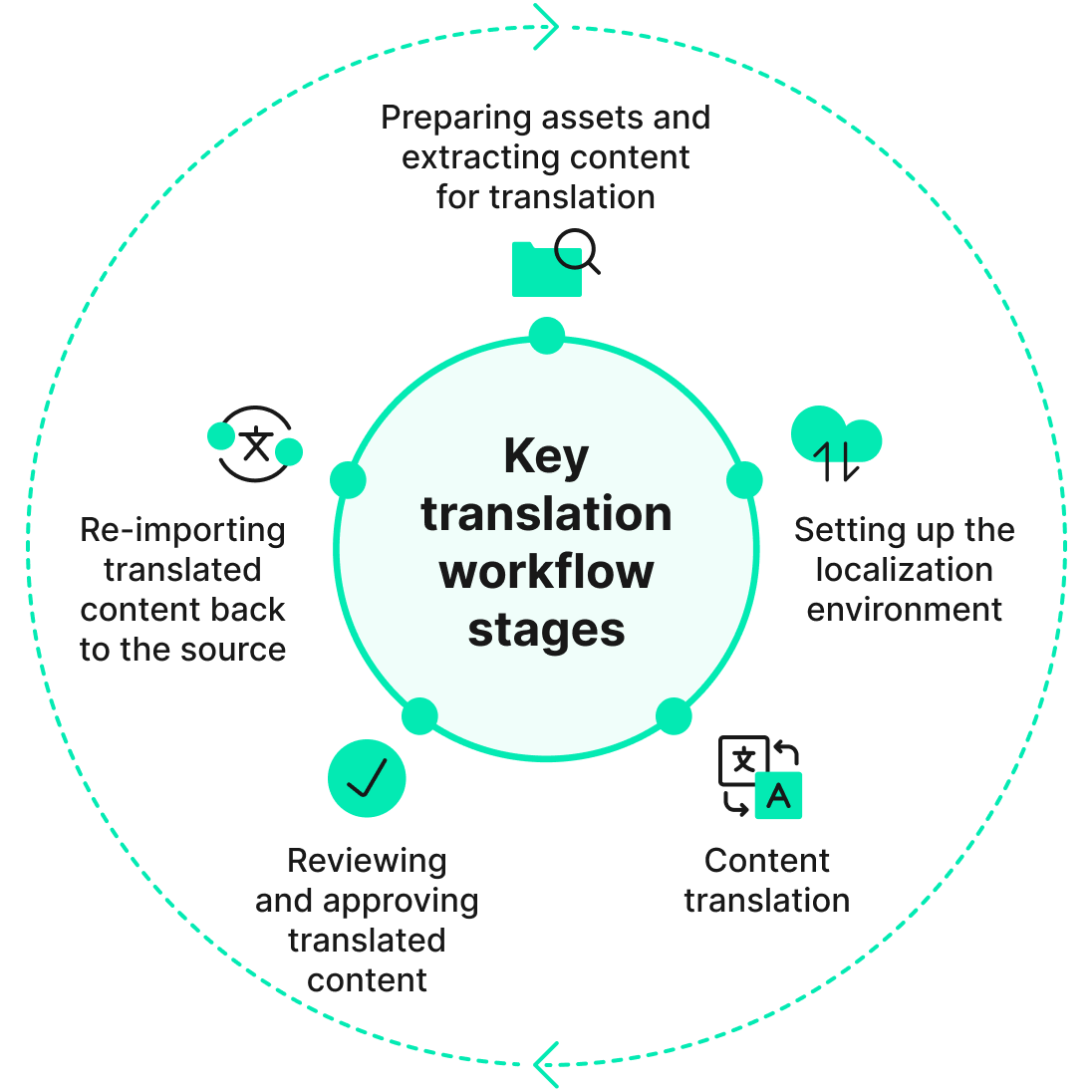
Preparing assets and extracting content for translation
The translation workflow begins with the preparation and extraction of content, i.e., making all assets available and suitable for localization. Developers will name and store each file appropriately for each language in a content repository, into which they will later import the translated content as an updated version of the same file.
A TMS simplifies this part by providing easy synchronization with repositories hosted on platforms like GitHub, GitLab, or Bitbucket. This allows translation project managers and developers to pull content from the repository and push translated versions back while keeping track of changes made.
Setting up the localization environment
Once the files are ready for translation, project managers need to assign a translator to a particular job. Whether an in-house team of translators or an external partner, a TMS makes it easy to manage their assignments and tasks in one place.
Automatic notifications, for example, help keep everybody informed about changes in project status, deadlines, added tasks, and other important updates. Some TMS solutions will even let you order professional translations from within the platform, eliminating the need to contact and onboard external vendors.
Content translation
Whether the project involves only human translation or combines MT and human work, the TMS provides an interface to facilitate transferring content between languages. Linguists can easily access their tasks, work in an easy-to-use editor that’s context-rich (automatically captured UI screenshots, term bases, feedback from stakeholders, etc.), and quickly submit their work for review.
The same goes for reviewers and editors—the platform allows them to get automated notifications when a project is ready for review, easily find the assigned tasks, review them, add notes or comments where appropriate, and flag any issues with the translation quality. If automated QA is enabled, the TMS can also flag consistency or quality issues automatically.
Reviewing and approving translated content
The translation workflow normally involves an internal review and approval step to ensure the accuracy and suitability of all translations. The TMS allows multiple stakeholders, such as project managers, designers, developers, marketing specialists, or other domain experts to review the content from a central location.
The system also lets project managers provide feedback on the translations quickly and easily—whether it’s a simple comment about stylistic preferences or more detailed instructions on how to fix an issue.
For example, if a text line overflows a call-to-action button in a particular language, project managers can easily flag it so translators can provide alternative translations that fit the space better.
Re-importing translated content for publishing back to the source
Reintegrating the content from translated text to the final format is the last step of the workflow. Deploying the translated content into a project, or pushing it to a production environment is done automatically in the TMS platform.
All stakeholders get notifications when the process is complete, and developers can easily check that all translations are in place and ready for launch.
Choosing the best translation management system for your needs
Depending on the nature of your product or service, type of content you have, and desired language combinations, choosing the best translation management system requires a set of factors to consider. Let’s have a look at the most important ones so you go for the TMS provider that best suits your business needs.
| Evaluation factors for translation management systems | |
| Automation | Automating repetitive or manual tasks saves time and effort for both project managers and linguists. A good TMS will include features such as automated notifications, QA checks, and more. |
| Usability | The TMS should be user-friendly, easy to learn and navigate, and provide a rich context experience that enables linguists to quickly find what they need. |
| Flexibility | A flexible TMS should allow you to set up and customize workflows, review processes, roles, user rights, and access levels to best meet the needs of different teams and stakeholders. |
| Scalability | Content-heavy companies shouldn’t have to worry about how many words, languages, or projects the TMS can manage. A robust solution should be able to easily scale up to meet your organization’s growing requirements. |
| Quality assurance | Besides including traditional CAT tools such as translation memories and term bases, a modern TMS should be able to automate QA checks to help translators fix typos, formatting issues, incorrect tagging, inconsistencies in terminology, etc. |
| Support for different file formats | A TMS should offer support for multiple file types, such as DOC, DOCX, CSV, XLSX, and more. |
| Integration | A TMS should provide native integrations with popular platforms and services—content management systems, project management solutions, etc.—with no need for middleware. Otherwise, make sure it has a strong API that can help you build your own integrations. |
| Predictable pricing | To measure ROI, you need to understand the total cost of ownership, as well as identify any hidden costs that might arise in the long run. The best TMS will offer flexible and predictable pricing structures—with no hidden fees for implementation, integration, training, maintenance, etc. |
| Machine translation capabilities | If you plan to use MT for a faster turnaround time, the TMS should offer a wide range of fully managed MT engines and automatically select the best engine for your content type and language pairs. |
| Access to data and customizable reporting | You need to be able to easily track the progress of your projects, measure translation efficiency, and monitor performance. The system should provide informative metrics that will allow you to quickly identify trends, spot areas for improvement, and make data-driven decisions. |
| Technical and customer support | Reliable customer service should be available at any time you may need help setting up or using the system. The TMS vendor should also provide regular updates, training sessions, and other resources that will help you maximize your productivity. |
| Robust security | The platform you select must guarantee secure data storage and transmission. Strict adherence to established regulations, two-factor authentication, on-premise hosting behind your firewall, and regular security audits are essential for protecting your data. |
| Free trial period | It’s important to be able to try out the platform before committing. The best TMS will offer a free trial period, allowing you to test the system and make sure it fits your business needs. |
Supercharge your translation management with Phrase TMS
It’s possible to get all of the above—and more—from Phrase TMS, the enterprise-ready translation management system within the Phrase Localization Platform. Companies worldwide rely on Phase TMS to reach global markets more quickly by efficiently translating their website, product documentation, sales presentations, marketing content, etc.
With Phrase TMS, you get:
- A fully-featured CAT tool with advanced features such as automated QA checks and a visual editor with real-time previews of translated content
- Powerful automation capabilities
- Translation memory to keep you from translating the same work twice
- Term base to help translators stick to your preferred terminology
- Automated translation quality assurance to keep translations accurate and consistent
- 30+ integrations, from content management systems and marketing automation platforms to source code repositories and other 3rd-party systems
- The choice to utilize add-ons for what matters most to your organization:
- Phrase Orchestrator for building automated workflows
- Phrase Analytics for creating detailed custom reports
- Phrase Language AI for leveraging machine translation technology
- The possibility to order professional translation services in one click and manage them from within a single platform
- Robust security features to ensure secure data storage and transmission
- Comprehensive technical support and customer service
- A predictable and flexible pricing model
- A free trial period to test the platform before committing
Phrase TMS is the best choice for enterprises looking to speed up their translation process and expand their global reach in the native language of their customers. Try it out today, and see why it’s the top-ranked translation translation management system on the market.

Phrase TMS
The enterprise-ready translation management system
Work with the leading TMS to automate translation workflows with cost control and quality checks.





